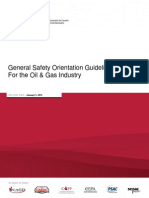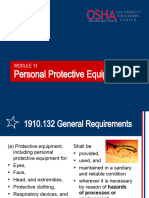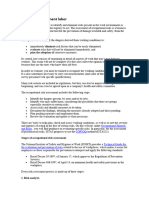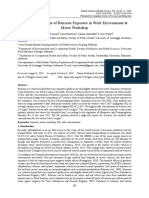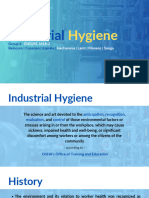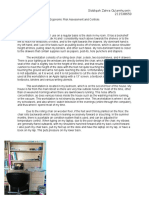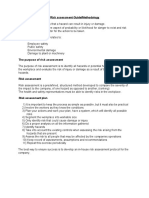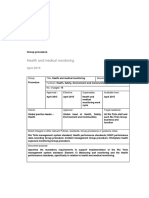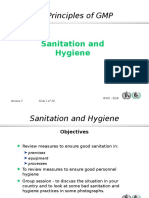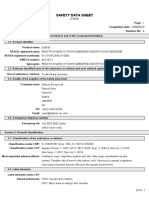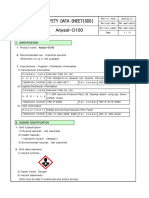Chapter 1-Introduction To Osha
Chapter 1-Introduction To Osha
Uploaded by
fettaneCopyright:
Available Formats
Chapter 1-Introduction To Osha
Chapter 1-Introduction To Osha
Uploaded by
fettaneOriginal Description:
Original Title
Copyright
Available Formats
Share this document
Did you find this document useful?
Is this content inappropriate?
Copyright:
Available Formats
Chapter 1-Introduction To Osha
Chapter 1-Introduction To Osha
Uploaded by
fettaneCopyright:
Available Formats
CHAPTER 1-
INTRODUCTION TO OSHA
AN INTRODUCTION
OSH 1994(Act 154) is an act to make
further provisions for
1. securing the safety, health and
welfare of persons at work
2. protecting others against risks to
safety or health in connection with the
activities of persons at work
CONT
Legislation on occupational safety
and health was made in the year
1994.
ITS CONSIDERING THAT
The fact that the Factory and
Machinery Act 1967 only covers
occupational safety and health in
the manufacturing, mining,
quarrying and construction
industries, whereas the other
industries are not covered.
DID YOU KNOW
Workers that are covered by
Factory and Machinery Act
1967 consists only of 24% of
the nations total man power,
while Occupational Safety and
Health 1994 would cover 90%
of the nations total man power
PURPOSE OF OSHA
To promote and encourage
occupational safety and health
awareness among workers and to
create organisation along with
effective safety and health
measures.
CONTAIN OF OSH 1994
1. 15 section- is a measure that
supersedes any conflict in existing
occupational safety and health laws
2. Regulation and Legislation
3. The responsibilities of employers,
manufacturer, employees, self-
employed workers, designers,
importers and vendors
LEGISLATION THAT CONNECTED
TO OSHA
1. Act
2. Regulation
3. Code of Practice
4. Order
5. Guideline
OBJECTIVES OF OSHA
to secure the safety, health and welfare of
persons at work against risks to safety or
health arising out of the activities of
persons at work;
to protect persons at a place of work
other than persons at work against risks
to safety or health arising out of the
activities of persons at work;
OBJECTIVES OF OSHA
to promote an occupational environment for
persons at work which is adapted to their
physiological and psychological needs;
to provide the means whereby the
associated occupational safety and health
legislations may be progressively replaced by
a system of regulations and approved
industry codes of practice operating in
combination with the provisions of this Act
designed to maintain or improve the
standards of safety and health.
SAFETY IN WORKPLACE
DUTY OF CARE
Employer has a duty to ensure that
workers and others are not exposed
to risks to health or safety arising
from the conduct of the employer's
business
So every employee must have the
general statutory duty of care that
carry out by employer
PURPOSE OF DUTY CARE
identify hazards
identify, and assess the seriousness of,
risks resulting from the hazards
determine appropriate risk management
measures (e.g. eliminate, minimize)
carry the risk management measures into
effect and minimize risk
monitor and review the effectiveness of
the measures.
DUTIES IN A WORKPLACE
Employer take practical measure to :
a. Workplace (entering and leaving) are
safe
b. a person who designs, constructs,
manufactures, imports, installs or
supplies a workplace or any part or
component of a workplace.
c. An owner or occupier of the workplace
DUTIES TO WORKPLACE
EQUIPMENT
Employer take practical measure to
ensure :
1. workplace infrastructure or
equipment are safe
2. worker instructed in the use, and
warned about risks involved in the use,
of workplace infrastructure or
equipment,
3. worker known about workplace
materials are poisonous
GENERAL DUTIES
EMPLOYER TO EMPLOYEE
1. Ensure the safety, health and welfare at
work of all his employees.
2. Ensure the maintenance of plant and
systems of work that are safe and
without risks to health
3. Ensure practicable, safety and absence
of risks to health in connection with the
use or operation, handling, storage and
transport of plant and substances
EMPLOYER TO EMPLOYEE
4. Provide training, information and
supervision to worker
5. maintenance of workplace condition are
safe and the means of access to and
egress from it that are safe
6. Working environment is safe as regards
facilities for their welfare at work.
EMPLOYER TO OTHER PERSON
1. Ensure that he and other persons, not
being his employees, who may be
affected thereby are not thereby
exposed to risks to their safety or
health.
EMPLOYEE
1. to take reasonable care for the safety
and health of himself and of other persons
who may be affected by his acts or
omissions at work
2. to co-operate with his employer or any
other person in the discharge of any duty
or requirement imposed on the employer
or that other person by OSH Act or any
regulation
EMPLOYEE
3. to wear or use at all times any protective
equipment or clothing provided by the
employer for the purpose of preventing
risks to his safety and health
4. to comply with any instruction or
measure on occupational safety and
health instituted by his employer or any
other person
FACTORY AND MACHINERY ACT
An Act to provide for the control of
factories with respect to matters
relating to the safety, health and
welfare of person therein, the
registration and inspection of
machinery and for matters
connected therewith.
SAFETY AND HEALTH
ORGANIZATION
DOSH
- starting from April 1994 the
Department of Factory and
Machinery has been renamed as the
Department of Occupational Safety
and Health (DOSH) and the
Inspectors are called Occupational
Safety and Health Officers
FUNCTION OF DOSH
To study and review the policies and
legislations of occupational safety and
health.
To enforce the following legislations :
A) Occupational Safety and Health Act
1994 and its regulations.
B) Factories and Machinery Act 1967 and
its regulations.
C) Part of Petroleum Act 1984 (Safety
Measures) and its regulations.
FUNCTION OF DOSH
To conduct research and technical
analysis on issues related to occupational
safety and health at the workplace.
To carry out promotional and publicity
programs to employers, workers and the
general public to foster and increase the
awareness of occupational safety and
health.
FUNCTION OF DOSH
To become a secretariat for the National
Council regarding occupational safety and
health
NIOSH
NIOSH (National Institute of Occupational
Safety and Health) was established on 24
June 1992 as a Company Limited by
Guarantee, under the Malaysian
Companies Act, 1965.
FUNCTION OF NIOSH
1. To provide training and education of Safety
and Health
2. Organize and participate in Safety and
Health exhibition
3. Organize and participate in Safety and
Health seminar and conferences
4.Support industries in their safety and health
campaign activities
SOCSO
SOCSO was established in1971 to
implement and administer the social
security scheme under the Employees
Social Security Act 1969 (Act 4)
Under the scheme, worker are protected
against industrial accident including
accident occur while working,
occupational diseases, invalidity or death
due to any cause.
FUNCTION OF SOCSO
1. registration of employer and employee
to SOCSO Scheme
2. collecting contribution, processing
benefit claim and make payment to
injured worker and their dependents.
3. provide vocational and physical
rehabilitation benefits and enhance
occupational safety and health
awareness of worker.
ANY QUESTION ???
You might also like
- Benzene: 1. Purpose 2. ScopeDocument8 pagesBenzene: 1. Purpose 2. ScopeKandhasamy888No ratings yet
- General Safety Orientation Guidelines (Replaced Irp 16)Document29 pagesGeneral Safety Orientation Guidelines (Replaced Irp 16)dinuveraNo ratings yet
- Nature Walk Risk AssessmentDocument7 pagesNature Walk Risk Assessmentapi-376126046No ratings yet
- Contractor Safety ManagementDocument18 pagesContractor Safety ManagementTim Yap100% (2)
- DRRR 2nd ExamDocument3 pagesDRRR 2nd ExamMichelle Kambwili100% (3)
- Dole Osh ComplianceDocument12 pagesDole Osh ComplianceLyndon Jay CalboneNo ratings yet
- Quiz Ppe Employee PDFDocument2 pagesQuiz Ppe Employee PDFSakshiNo ratings yet
- Chapter 3.1 Introduction To Industrial Hygiene and Occupational HealthDocument27 pagesChapter 3.1 Introduction To Industrial Hygiene and Occupational HealthHafizudin DaudNo ratings yet
- 2 Industrial HygieneDocument6 pages2 Industrial HygieneSayed DarwishNo ratings yet
- Personal Protective EquipmentDocument41 pagesPersonal Protective EquipmentHimel Kishor BaruaNo ratings yet
- Occupational Risk AssessmentDocument20 pagesOccupational Risk AssessmentScribdTranslationsNo ratings yet
- Safety ManualDocument21 pagesSafety ManualAli ImamNo ratings yet
- Employee Safety and Health at Work.2Document73 pagesEmployee Safety and Health at Work.2Jennelyn SantosNo ratings yet
- Occupational Safety and HealthDocument39 pagesOccupational Safety and Healthmahadevi ganiger100% (1)
- Btex Regulasi IndonesiaDocument7 pagesBtex Regulasi IndonesiaPriyo DjatmikoNo ratings yet
- Industrial HygieneDocument63 pagesIndustrial HygienePrincess Rau Cunanan100% (1)
- Health and Safety OHSADocument8 pagesHealth and Safety OHSAFlávia TavaresNo ratings yet
- Industrial HygieneDocument70 pagesIndustrial Hygienechimaraiyke100% (2)
- OHS Baseline Risk Assessment - Catering Contract October 2021Document18 pagesOHS Baseline Risk Assessment - Catering Contract October 2021denoiNo ratings yet
- H S M P: Environmental Health and Safety OfficeDocument21 pagesH S M P: Environmental Health and Safety OfficeIjaz HussainNo ratings yet
- Accident CausationDocument35 pagesAccident CausationAntonio Jose De JesusNo ratings yet
- Hazard Communication OSHA Standard: Goal ProceduresDocument4 pagesHazard Communication OSHA Standard: Goal ProceduresLorena ZoraideNo ratings yet
- Fire Risk Assessment and Emergency Route Decision Analysis Based On Big Data Platform-Example of HuizhouDocument12 pagesFire Risk Assessment and Emergency Route Decision Analysis Based On Big Data Platform-Example of HuizhouPriyanka KilaniyaNo ratings yet
- Occupational Health Hazards and Safety Practices: Industrial Hygiene and SanitationDocument32 pagesOccupational Health Hazards and Safety Practices: Industrial Hygiene and SanitationPhilemon MsangiNo ratings yet
- Unit 01 ETUET-1-0005-1-3: Understand Occupational Health and SafetyDocument56 pagesUnit 01 ETUET-1-0005-1-3: Understand Occupational Health and Safetyshaista100% (1)
- 1819 Exide Dust Control Plan 11162012Document27 pages1819 Exide Dust Control Plan 11162012Yam BalaoingNo ratings yet
- Test S&HDocument5 pagesTest S&HHf CreationNo ratings yet
- Chemical and Biological Hazard Policy 2011Document21 pagesChemical and Biological Hazard Policy 2011Sivasankaran Nair HaridasNo ratings yet
- Risk Management or Environmental Health and Safety or Safety ManDocument3 pagesRisk Management or Environmental Health and Safety or Safety Manapi-121419389No ratings yet
- Ergonomic Risk Assessment and ControlsDocument4 pagesErgonomic Risk Assessment and ControlsSarfaraj OviNo ratings yet
- IG2 Element 7Document84 pagesIG2 Element 7Shabry SamoonNo ratings yet
- Msds Saj Coshh 0383Document3 pagesMsds Saj Coshh 0383Kannan Sasidharan PillaiNo ratings yet
- Occupational HealthDocument8 pagesOccupational HealthIya JoyNo ratings yet
- Procedureriskassessment PDFDocument20 pagesProcedureriskassessment PDFMinhDũngNo ratings yet
- Biological Monitoring (Dr. Siswanto)Document134 pagesBiological Monitoring (Dr. Siswanto)Dhery Dev WhitterNo ratings yet
- Lecture Note Employee SafetyDocument7 pagesLecture Note Employee Safetyspecies09No ratings yet
- Chapter 5 - Control of Safety and Health RisksDocument58 pagesChapter 5 - Control of Safety and Health RisksEdgar LacsaNo ratings yet
- Manual Handling AssessmentDocument13 pagesManual Handling AssessmentCarlos CelestinoNo ratings yet
- Respiratory Protective Equipment (RPE) : Offshore Coshh EssentialsDocument3 pagesRespiratory Protective Equipment (RPE) : Offshore Coshh Essentialsjnacer nacerNo ratings yet
- Risk Assessment For Collaborative OperationDocument23 pagesRisk Assessment For Collaborative OperationTata OdoyNo ratings yet
- Workplace ViolenceDocument27 pagesWorkplace Violencealit2No ratings yet
- Risk Assessment Guidelines - 9cb0Document11 pagesRisk Assessment Guidelines - 9cb0andaminiNo ratings yet
- XBLR3103 - OSH Legislation W1-W2Document49 pagesXBLR3103 - OSH Legislation W1-W2Islah Dean100% (1)
- Health and Safety Management Committee TorDocument2 pagesHealth and Safety Management Committee TorArul SelvanNo ratings yet
- Vinay K Khanna - Occupational Health (Rajendra)Document34 pagesVinay K Khanna - Occupational Health (Rajendra)Nora FahsyaNo ratings yet
- Job Hazard Analysis ProcedureDocument2 pagesJob Hazard Analysis Procedureleojay24No ratings yet
- 08PR138C - Management of Tyre Fire ExplosionDocument5 pages08PR138C - Management of Tyre Fire Explosionkenoly123No ratings yet
- Safe WorkplaceDocument17 pagesSafe WorkplacePradeep KumarNo ratings yet
- 22 02risk Assessment MethodologyDocument3 pages22 02risk Assessment MethodologyPieter HerbstNo ratings yet
- ABC's of Fall Protection: Murray State University Susan MillerDocument24 pagesABC's of Fall Protection: Murray State University Susan MillerSam SalesNo ratings yet
- Lecture 1 Introduction To Industrial HygieneDocument40 pagesLecture 1 Introduction To Industrial Hygienesiti zubaidahNo ratings yet
- Reporting, Recording and InvestigationDocument28 pagesReporting, Recording and InvestigationAnnNo ratings yet
- Sample Hearing Conservation Program: PurposeDocument4 pagesSample Hearing Conservation Program: PurposevictorNo ratings yet
- 1658936909.7522428 - Gilley Enterprises Inc Workplace Violence and Prevention PolicyDocument7 pages1658936909.7522428 - Gilley Enterprises Inc Workplace Violence and Prevention PolicyJhems ElisNo ratings yet
- Aprile HSES PolicyDocument2 pagesAprile HSES PolicyAprile NetworkNo ratings yet
- Industrial HygieneDocument18 pagesIndustrial HygieneLadyshiela CuberoNo ratings yet
- IGC1 Element 4 End of Element Questions and Answers Health and Safety Management Systems 3 - PlanningDocument5 pagesIGC1 Element 4 End of Element Questions and Answers Health and Safety Management Systems 3 - PlanningDrmusharraf AnsariNo ratings yet
- Module 5 Identifying HazardsDocument4 pagesModule 5 Identifying HazardstucaharaNo ratings yet
- 5 - Risk AssessmentDocument8 pages5 - Risk AssessmentAldrien CabinteNo ratings yet
- Hazard Register ConstructionDocument15 pagesHazard Register ConstructionMohd ObaidullahNo ratings yet
- Procedure: (Optional Heading Here. Change Font Size To Suit)Document4 pagesProcedure: (Optional Heading Here. Change Font Size To Suit)Ian Kristian BelgicaNo ratings yet
- Health and Medical Monitoring Group ProcedureDocument14 pagesHealth and Medical Monitoring Group ProcedurenickNo ratings yet
- Educ Volunt Eng TalkDocument23 pagesEduc Volunt Eng TalkfettaneNo ratings yet
- Introduction To OshaDocument44 pagesIntroduction To Oshafettane100% (1)
- Engineering DisastersDocument22 pagesEngineering DisastersfettaneNo ratings yet
- Ford Pinto Engineering DisasterDocument1 pageFord Pinto Engineering DisasterfettaneNo ratings yet
- Professional Ethics - Bhopal Incident Case StudyDocument17 pagesProfessional Ethics - Bhopal Incident Case Studyfettane100% (1)
- Job Safety Analysis (Jsa) and Risk Assessment Form: WastonoDocument8 pagesJob Safety Analysis (Jsa) and Risk Assessment Form: WastonoPutra FeraNo ratings yet
- Defend 630 BaseDocument9 pagesDefend 630 BaseMohamed NouzerNo ratings yet
- MSDS Ethanol (64-17-5) by ThermoFisher (2018)Document8 pagesMSDS Ethanol (64-17-5) by ThermoFisher (2018)Torero020% (1)
- Unit 01 ETUET-1-0005-1-3: Understand Occupational Health and SafetyDocument56 pagesUnit 01 ETUET-1-0005-1-3: Understand Occupational Health and Safetyshaista100% (1)
- Hazard Prevention and ControlDocument8 pagesHazard Prevention and ControlNeil Cody A. JeliangNo ratings yet
- Basic Principles of GMP: Sanitation and HygieneDocument26 pagesBasic Principles of GMP: Sanitation and Hygienezakx24x7bd100% (1)
- Osha Project Presentation 2Document9 pagesOsha Project Presentation 2Rome GentaNo ratings yet
- Safety Engineering and JhaDocument29 pagesSafety Engineering and JhaDarren Dela CruzNo ratings yet
- Sf8 Nutritional-Stat-Baseline 6 Pearl 2022Document8 pagesSf8 Nutritional-Stat-Baseline 6 Pearl 2022Dante Maligsa BautistaNo ratings yet
- Msdsdvb80eu PDFDocument10 pagesMsdsdvb80eu PDFJamil BadarNo ratings yet
- Safety Data Sheet (SDS) Anysol-D100Document11 pagesSafety Data Sheet (SDS) Anysol-D100U.s. Ezhil ArivudainambiNo ratings yet
- IAMSAR Search PatternsDocument9 pagesIAMSAR Search PatternsGovind PrabhakumarNo ratings yet
- Coronavirus - Covid 19 Pandemic RMT Advice To Members Employed in The Rail IndustryDocument3 pagesCoronavirus - Covid 19 Pandemic RMT Advice To Members Employed in The Rail IndustryRMT London CallingNo ratings yet
- Safety AssignmentDocument5 pagesSafety AssignmentWK PangNo ratings yet
- MSDS Toner CartridgeDocument7 pagesMSDS Toner CartridgeAndrianoNo ratings yet
- Health and Safety Hazards in Tunnel ConstructionDocument2 pagesHealth and Safety Hazards in Tunnel ConstructionZainab FaisalNo ratings yet
- Penyusunan Rencana Manajemen Keselamatan Lalu Lintas Proyek Tol Pandaan - MalangDocument6 pagesPenyusunan Rencana Manajemen Keselamatan Lalu Lintas Proyek Tol Pandaan - MalangicaaaaaaaaaaaaaNo ratings yet
- 37 Material StorageDocument5 pages37 Material StorageKhuda BukshNo ratings yet
- Risk Assessment Form-DECADocument3 pagesRisk Assessment Form-DECAHill CordialNo ratings yet
- Session 7 - Risk AssessmentDocument34 pagesSession 7 - Risk Assessmentamit singhNo ratings yet
- HSE-000-GUD-0001 Guideline To Elaborate HSE PlanDocument16 pagesHSE-000-GUD-0001 Guideline To Elaborate HSE PlanernestoNo ratings yet
- CHESM Qualification QuestionnaireDocument46 pagesCHESM Qualification QuestionnairePikuNo ratings yet
- HSE Plan Contractor Pertamina Retrofit PIN (Assesment & Trouble Shooting PC CEMSDocument21 pagesHSE Plan Contractor Pertamina Retrofit PIN (Assesment & Trouble Shooting PC CEMSNanangAji100% (3)
- Ce Este Un Igienist IndustrialDocument2 pagesCe Este Un Igienist IndustrialCristina ConstantinNo ratings yet
- Risk AssessmentDocument5 pagesRisk Assessmentapi-480079676No ratings yet

